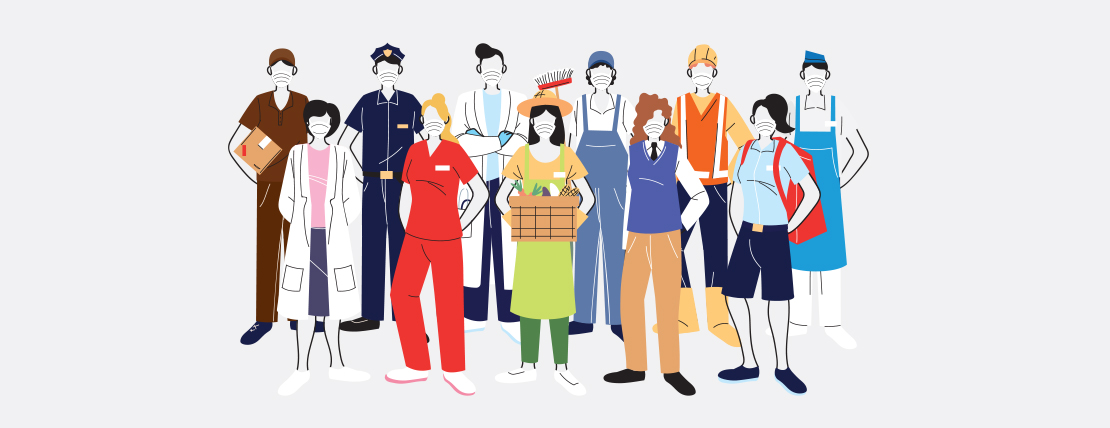Wondering what the future of learning looks like? Take a look at frontline employees for the answers. Even if you don’t have frontline workers in your company, you can still glean important lessons by looking at these workers’ learning experiences last year.
When work changed dramatically in 2020, learning was forced to change as well. Although everyone was affected by the changes, the front line, where 80% of global employees work, was affected most. Safety became the priority. Furloughs forced people in and out of the workplace for weeks at a time. People had to relearn how to do their jobs under the most challenging circumstances imaginable.
To even operate in this swirl of change, companies had to rapidly reimagine the frontline learning experience. During the pandemic, nearly half (46%) of frontline employees took on new tasks and 23% filled new positions altogether, according to The “State of Frontline Employee Training 2020” research report from Arlington Research and Axonify. Because of this, frontline workers are now ahead of the curve for agile learning strategies.
The hard-won learning experiences of frontline employees can show what any company can anticipate and prioritize to prepare for the challenges of 2021.
Four Takeaways from the Frontline Learning Experience
- Reskilling needs to be an essential, ongoing practice. Throughout the pandemic, the skills narrative dominated the conversation. We’ve all talked about reskilling for a long time, but it was always in a vague, future-of-work way. But as the pandemic hit, frontline employees needed to develop specific skills almost overnight that they would use immediately on the job. Bank tellers had to become contact center agents. Grocery cashiers had to learn how to do grocery delivery. What was still a conversation about reskilling in the corporate learning environment was a frank reality on the front line.
Employees needed programs that helped them rapidly pick up new skills for these roles. But frontline employees were too in demand to take time away from their work to attend a training program. They had to get their instruction on the job. Companies could give employees enough information to get started quickly and then provide ongoing development.
What can corporate environments learn from the reskilling of frontline employees? Reskilling is no longer a futuristic concept but an immediate need. Although corporate employees require different skills than those on the front line, education still needs to be specific, targeted and immediately applicable. - Businesses should rethink the use of digital technology. During the pandemic-related lockdowns, retail companies wanted to update employees as regulations, hours and policies changed frequently. Many frontline employees have little access to offices for team meetings or computer equipment for Zoom calls. Companies had to reach frontline employees wherever they were. Beyond communicating through mobile devices, companies had to ensure employees had access to the information on demand, regardless of the technology used. The front line had to proactively reimagine what “digital” means and how to make it work for a mobile workforce.
While corporate environments are still wrestling with whether employees should bring their own devices to work, a more significant issue is how to use digital tools to help people develop and stay up to speed. Like businesses with frontline employees, corporate leaders should rethink what their technology can do and how it can help people do their jobs better. - Microlearning needs to be iterative. Microlearning has been critical in helping frontline workers reskill for additional roles. Microlearning allows employees to focus on a specific set of skills they need. It gives them a jump start so they can use the skills right away without disrupting the workday. To be an effective learning method, microlearning can’t be one and done. Lessons need to build in an iterative way, enabling employees to eventually develop a thorough grasp of their responsibilities.
Microlearning can also be provided to seamlessly fit into the employee work experience in a corporate environment. For example, a coaching development program could break the teaching into a focused set of topics and skills. As an employee demonstrates those skills, more skills are added and continuously reinforced. - Businesses must find ways to measure training’s impact. The entire industry struggles with showing how learning and development affects results. It is often easier to measure frontline training because it is more explicit. That’s a good thing, because the front line doesn’t have the luxury of missing the mark on training now. They’ve learned their investment must lead to job improvement and business results. To know that is happening, they know they need to connect explicitly defined skills to measurable components of the business.
Granted, measuring impact is trickier in a corporate environment. We can get data on how many sales a retail associate made in a day. Still, it’s harder to assess the bottom-line impact that a marketing professional had on developing a promotion. Nevertheless, you can look for areas where you can explicitly define skills and connect them to measurable components of the business. This data will help determine if the training is working.
The frontline workforce rapidly kept pace with changes by rethinking learning and development, building new skills and applying them quickly. Other businesses can take some of these learnings and ideas that are proving successful in the face of disruption and install the right pieces so they are ready for whatever changes come next.







